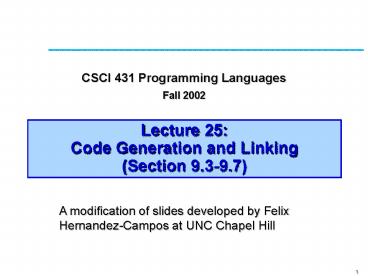Lecture 25: Code Generation and Linking Section 9.39.7 - PowerPoint PPT Presentation
Title:
Lecture 25: Code Generation and Linking Section 9.39.7
Description:
Each library resides in its own code and data segment ... Program instances share a system-wide read-only copy of the the library's code segment ... – PowerPoint PPT presentation
Number of Views:72
Avg rating:3.0/5.0
Title: Lecture 25: Code Generation and Linking Section 9.39.7
1
Lecture 25Code Generation and Linking(Section
9.3-9.7)
- CSCI 431 Programming Languages
- Fall 2002
A modification of slides developed by Felix
Hernandez-Campos at UNC Chapel Hill
2
Phases of Compilation
- The first three phases are language-dependent
- The last two are machine-dependent
- The middle two dependent on neither the language
nor the machine
3
Example
- program gcd(input, output)
- var i, j integer
- begin
- read(i, j)
- while i ltgt j do
- if i gt j then i i j
- else j j i
- writeln(i)
- end.
4
Example Control Flow Graph
- Basic blocks are maximal-length set of sequential
operations - Operations on a set of virtual registers
- Unlimited
- A new one for each computed value
- Arcs represent interblock control flow
5
Code Generation
- We will illustrate the back-end with a simple
compiler - There is not control flow graph
- No optimizations
- Two main tasks
- Register allocation
- Instruction Scheduling
6
Code Generation Example
program gcd(input, output) var i, j
integer begin read(i, j) while i ltgt j
do if i gt j then i i j else j j
i writeln(i) end.
7
- Reserved registers a1, a2, sp and rv
- General purpose r1..rk
- Expression code generation (ab) ? (c (d/e)
Ri used as expression evaluation stack
8
Code Generation ExampleSyntax Tree and Symbol
Table
9
Code Generation ExampleAttribute Grammar
10
Code Generation Example
11
Code Generation Example
Allocation of next register
12
Code Generation Example
Register Spill
13
Code Generation Example
14
Code Generation Example
15
Code Generation Example
16
Address Space Organization
- Assemblers, linker and loader typically operate
on a pair of related file formats - Relocatable object code
- Input to linker
- Multiple file are combined to create an
executable program - It includes the following information
- Import table (named locations with unknown
addresses) - Relocation table (instruction that refer to
current file) - Export table
- Imported and exported names are known as external
symbols
17
Address Space Organization
- Executable object code
- Input to loader
- Loaded in memory and run
- A running program is divided into segments
- Code
- Constants
- Initialized data
- Uninitialized data
- Stack
- Heap
- Files (mapped to memory)
18
Linking
- Large program must be divided into separate
compilation units - E.g. main program and libraries
- The linker is in charge of joining together those
compilation units - Each compilation unit must a relocatable object
file - Linking involves two subtasks
- Relocation
- Resolution of external references
19
Relocation
- Two phases
- In the first phase
- Gather all the of the compilation units
- Choose an order in memory and note addresses
- In the second phase
- Resolve external references on each unit
- Modify instruction set as required
- Linking also involved type checking using module
headers
20
Linking Example
- Two relocatable object files are linked in this
example, A and B - M and X are external references
- L and Y are internal refereces
21
Linking Example
22
Dynamic Linking
- In many modern systems, many programs share the
same libraries - It is a waste to create a copy of each library at
run-time - Most operating system support dynamically linked
libraries (DLLs) - Each library resides in its own code and data
segment - Program instances that uses the library has
private copy of the data segment - Program instances share a system-wide read-only
copy of the the librarys code segment - DLLs support backward-compatible without
recompilation

